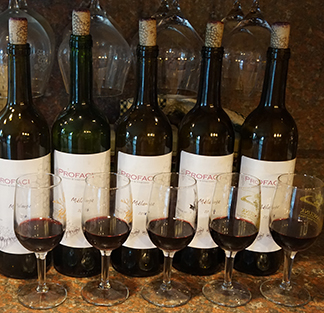Winemaker: Greg Pollman started working at Fountain Wine Cellars in Cincinnati in 1974 and went to Sublette Winery in Cincinnati in the late 70s. He joined Valley Vineyards Estate Winery in Morrow, Ohio in 1984 and now is the company’s winemaker.
Spring is a good time to start thinking about bottling. Blushes or whites with some residual sugar are usually ready six to nine months after harvest. By that time the fermentation is done, and by bottling in the spring I think you’re preserving much of the essence of the grape.
Red wines from the fall might be ready to bottle in the beginning of the summer. Lighter reds don’t need much more than six months of aging, especially if you aren’t oaking heavily.
When you are getting ready to bottle, the first thing to check is whether the wine is cold stabilized. Lots of home winemakers put their carboys in the garage during the winter. The cold temperatures precipitate out all the tartrate crystals. You can rack off these crystals before you bottle. The benefit is that the crystals will not settle in the bottle. Tartrate crystals don’t hurt your wine — they’re just rather unattractive to look at.
A good way to test for cold stabilization is to remove a small sample into a clear bottle or jar, seal it, and put it into the refrigerator. After a few weeks, you’ll see if any more crystals have settled. If there are no more tartrate crystals, you’re ready to bottle.
You also need to check if there is residual sugar in the wine. You can get many kinds of test kits. I know of some home winemakers who buy a diabetes test kit, which is designed to test for sugar in urine, from their local pharmacy. It’s easy to use.
If you detect residual sugar, give your wine a few more weeks to finish fermentation. If, after this, you still find residual sugar, you’ll need to use potassium sorbate as a yeast inhibitor. Use this at a rate of one gram per gallon.
You’ll also want to test for sulfur dioxide, which is a preservative and anti-oxidant. I like to use 30 parts per million of free SO2 in my wine as a general rule of thumb. If it’s too low, slowly add some Campden tablets or potassium metabisulfite powder until you reach your desired level. If it’s too high, try blending with a similar type of wine (with a lower SO2 content) or aerate the wine a little bit.
You can generally avoid oxidation concerns with careful racking and bottling. Just be careful not to agitate the wine. Go slow while bottling. Try using one of those spring-loaded bottle fillers rather than a hose and clamp. Spring-loaded bottle fillers give you a consistent fill level and prevent splashing.
As for corks, plastic corks often need a vacuum corker to put them in. I prefer natural corks, which have proven themselves over the long haul.
Winemaker: Jamie Macfarlane graduated with a Bachelor of Arts in Biology from Queen’s University in Kingston, Ontario and studied winemaking in Côte-d’Or and Montpellier in France starting in 1982. He has worked for Bright’s Wines and Kittling Ridge Wines and Spirits in Ontario, and he is presently the Director of Oenology for Andres Wines in Grimsby, Ontario.
Really, the only reason not to bottle a wine is because it is undergoing some further process, such as barrel aging or oak treatment. Aromatic whites benefit from “early” bottling (and consumption) to capture the fresh-fruity aromas. Keep the wine in its safest storage place — a bottle in a cool cellar is better than a carboy in your garage.
When you’re looking at the wine in your carboy, think clarity. The clearer the better, in fact. You’ll have sediment at the bottom to rack off of before bottling. Racking provides additional clarity. It also removes microorganisms that have settled on the bottom of the carboy. Racking off these organisms results in greater wine stability.
It would be terrible to ruin your wine at this stage of the process. So when it comes to bottling, make sure all the equipment that will touch the wine, like your siphon hose and bottles, are cleaned and sanitized. Also beware of aerating the wine, which causes oxidation. Be gentle during the transfer from carboy to bottle.
In fact, at bottling you want to avoid oxygen altogether. It can chew up your stable SO2, oxidize your wine and — as all spoilage bacteria are aerobic and require O2 — can cause further spoilage that will ruin your wine.
Strangely enough, screw caps provide the best seal. This means you’ll suffer less oxygen transmission and no corkiness. For corks, synthetic are often dependent on the right kind of equipment to put them in. Avoid cheap corks, as they often result in leaks.
Winemaker: Dr. Ken Groninga received a degree in veterinary medicine in 1962 from Iowa State University. He practiced for thirty years before retiring in 1994 to work as a consulting veterinarian for a veterinary biologic company. In 1991 Ken and his wife Carolyn bought acreage in a wooded area alongside the Iowa River near Ackley, Iowa. They began making wine from the various wild fruits and berries that grew on and around their acreage, such as elderberries, raspberries, mulberries, chokecherries and wild plums. In 1996, they began planting a small vineyard. They opened The Eagle City Winery in June of 2000, producing about 800 to 1000 gallons of wine per year.
I store my filtered wine that is ready to bottle in the same kind of glass carboys used by many home winemakers. Wine will age quite well in carboys and in bottles. For me, the decision about when to bottle depends on the size of my inventory in bottles and how badly I need the carboys for aging another wine.
As the wine is aging in the carboys, I’ll keep a close eye on the specific gravity. As a general rule of thumb, if the wine reaches a specific gravity below 0.994 and has good clarity, aroma and bouquet, I will go ahead and bottle it.
Oxygen can ruin a perfectly good wine. I do everything possible to avoid agitating the wine while bottling. I also top off my bottles with nitrogen gas before corking. I suggest home winemakers ask at their wine supply shop for equipment to “blanket” their wine with nitrogen. It’s a handy thing to have, both during bottling and during maturation in carboys.
For transferring the wine to a bottle, most home winemakers will find that a siphon hose and clamp works well. I use an automatic bottle filler that operates with a vacuum pump and can fill a bottle in about 15 seconds.
I began with real corks but had too many bottles that leaked. Sometimes, small pieces of cork ended up in the wine or a bottle would have a “corked” taste. For those reasons, I only use synthetic corks. I do not use bottlecaps and strongly discourage home winemakers from employing them.







